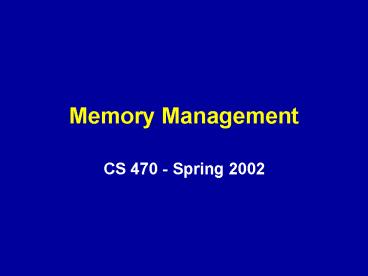Memory Management PowerPoint PPT Presentation
Title: Memory Management
1
Memory Management
- CS 470 - Spring 2002
2
Overview
- Partitioning, Segmentation, and Paging
- External versus Internal Fragmentation
- Logical to Physical Address Mapping
- Placement Algorithms
- First Fit, Next Fit, and Best Fit
- Buddy System
- Intel X86 Memory Mapping Mechanisms
- Linking and loading executables
3
Memory Partitioning
- Fixed Partitions (IBM OS/MFT)
- Equal Partition Sizes
- Variable but fixed Partition Sizes
- Internal Fragmentation
- Dynamic Partitions (IBM OS/MVT)
- External Fragmentation
- Need for Compaction
4
Segmentation versus Paging
- Segmentation - Each process divided into variable
sized programmer visible segments. External
fragmentation. - Paging - Main memory divided into equal sized
programmer invisible pages. Trivial internal
fragmentation. - Simple (whole process loaded) versus Virtual
(parts of processes loaded)
5
Relocation
Segment or Partition Descriptor
Segment or Partition
Base Address
Size
Offset
Logical to Physical Translation
Size
Offset ? Size ? Address Exception
Base Addr Offset ?
Physical Address
6
Logical vs. Physical Addresses
- Allows processes to be physically scattered
throughout memory while logically contiguous -
i.e. programmer thinks it is all one contiguous
block of memory - Allows for physical movement without logical
movement - Allows processes to occupy same logical addresses.
7
Logical to Physical AddressTranslation
Logical Address
Page/Segment
Offset
000002
012345
512
4124000
0
4096
4129000
1
Process Page or Segment Table
102400
2010000
2
2022345
8192
7212300
3
Physical Address
Base Address
Segment Length
8
Inverted Page Table
Logical Address
Used in MacOS
Page/Segment
Offset
000612
012345
hash
512
4124000
2
409
4129000
-1
612
2010000
-1
2022345
27
7212300
1
Hash table
Physical Address
Page Nbr
Base Addr
Link
9
Placement Algorithms
- Trivial for allocating blocks of fixed size
- Given list of free blocks/partitions and their
lengths - First fit -- use first block of sufficient size
- Next fit -- use first block of sufficient size
after the one that was last allocated - Best fit -- use block whose size is smallest
amongst those of sufficient size.
10
Amount of Fragmentation
- First fit is easiest and causes least
fragmentation - Next fit requires remembered state and fragments
more because all blocks have equal chance to be
allocated - Best fit takes longest and almost guarantees lots
of small fragments - Can reduce external fragmentation if use only
multiples of minimal sized block.
11
Buddy System
- Uses blocks of fixed sizes 2i for L ? i ? U to
reduce fragmentation - i_List of free blocks of size 2i, L ? i ? U .
- If request is of size k where 2i-1 ? k ? 2i ,
allocate block of size 2i . - If none of size 2i , divide block of size 2i1
into 2 equal buddies - repeat recursively. - Coalesce buddies recursively when freed.
12
Address of Buddy
- Assume original block of size 2U is at address
which is even multiple of 2U - All blocks of size 2i are at address Addr
satisfying ( Addr (2i - 1)) 0. - Address of buddy obtained by inverting the ith
bit. The buddy is at address - ( Addr 2i ) ((Addr) 2i )
13
Buddy Memory Allocation
Free Lists
0
12
0
11
0
0
10
9
9
9
8
0
9
7
0
6
10
12
5
14
Buddy System Blocks
Free Block
Allocated Block
Allocator Return Value
Log2N 0
Log2N 5 - 12
Data Space (N - 4 bytes)
Forward Link
Back Link
N - 12 Bytes
15
Intel X86 Memory Mapping
- Supports both segmentation and paging
- 16 bit segment selector
- 13 bit segment number
- Descriptor Tables 0 Global, 1 Local
- 2 bit requested privilege level
- 32 bit segment offset
- 64 terabyte address space for each process
- Registers (GDTR, LDTR) point to descriptor tables
and give their length
16
Logical to Linear Mapping
0
31
0
2
3
15
Segment Offset
Seg Number
RPL
Seg Desc.
0
12
22
31
Dir
Page
Offset
Descriptor Table
Linear Address
17
Linear to Physical Mapping
Linear Address
Physical Address
0
31
0
12
22
31
Physical Address
Dir
Page
Offset
Page Table
Page Directory
Dir Entry.
Pg TblEntry.
CR3
18
Page/Directory Table Entry
31 12 9 8 7 6
5 4 3 2 1 0
Page Frame Addr
D
A
C D
R W
U S
V
W T
G L
L
V Valid R/W Read / Write U/S User /
Supervisor W/T Write through C/D Cache Disabled A
Accessed D Dirty L Large
page GL Global
19
Translation Lookaside Buffers
- Caches page table entries
- Separate TLB for each cache
- For Data cache, TLB depends on page size
- 4 way associative with 16 sets for 4K pages
- 4 way associative with 2 sets for 4MB pages
- For Code cache, TLB is 4 way associative with 8
sets
20
Linking and Loading
Module 1
Load Module
Module 1
Module 2
Loader
Module 3
Module 2
Library 1
Library 2
Module 3
Loaded Program
Linker
Library 1
Memory
Library 2
21
When to resolve addresses
- Load Module Types
- Absolute load modules
- Relocatable load modules
- Dynamic Run-time load modules
- Address Resolution Times
- Programming time
- Compile or assembly time
- Load module creation time
- Load time
- Run time
22
Dynamic Linking
- Run time references to routines in external
modules causes loading of that module and
resolution of the reference - Advantages
- Upgrade of libraries can occur without relinking
all the applications - Automatic sharing of libraries
- Complicates design and testing of applications

